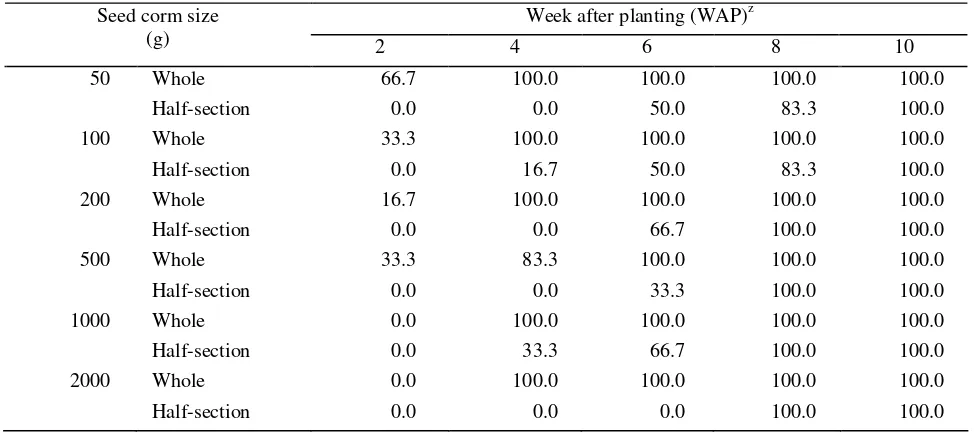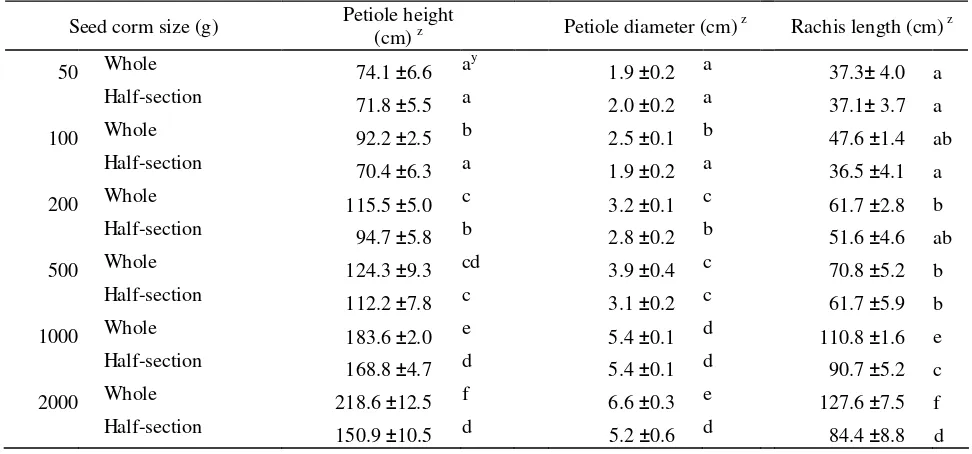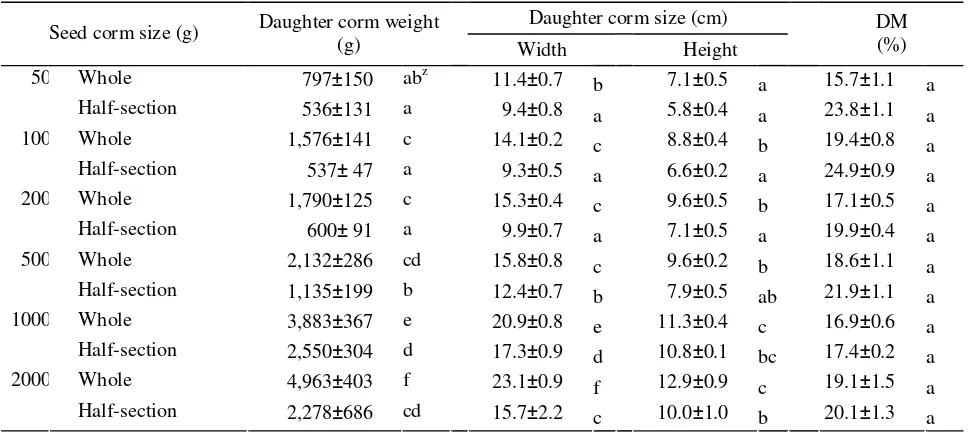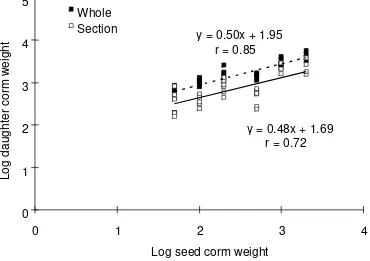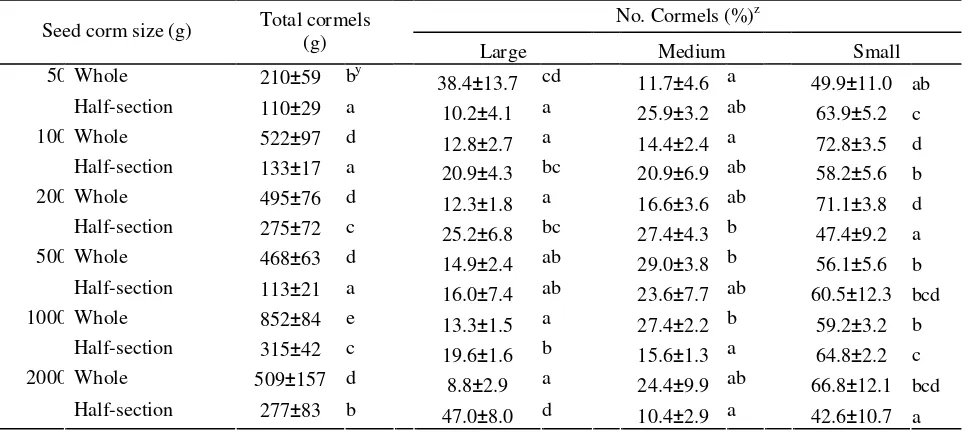1
Departement of Agronomy and Horticulture, Faculty of Agriculture, Bogor Agricultural University, Jl. Meranti Kampus IPB Darmaga, Bogor 16168 Indonesia. Telp/faks : +62(251)629353. Email: [email protected] (*Author for correspondence)
2
Graduate School of Agricultural and Life Sciences, The University of Tokyo, Tokyo 113-8657, Japan
Growth and Production of Amorphophallus paeoniifolius Dennst. Nicolson from Different Corm Weights
Edi Santosa1* and Nobuo Sugiyama2 Diterima 16 April 2007/Disetujui 26 Juli 2007
ABSTRACT
The effect of different seed corm weight on the growth and production of elephant foot yams (Amorphophallus paeonifolius Dennst. Nicolson) were studied. Two forms of corm with same weight were prepared, i.e., whole corm and vertically sectioned by 1/2. The fresh mass of each whole corm and corm section was the same. Six different corm weights were compared, i.e., 50, 100, 200, 500, 1000 and 2000 g. Growth and development of elephant foot yam were determined by corm weigth, large seed corm produced larger leaf and fresh mass of daughter corms. On the contrary, number of leaf decreased with increasing seed corm weight. Plants from whole seed corms emerged earlier and they were larger than those from the sectioned corms, irrespective of weight. Plants from small sized whole corm emerged earlier than the larger ones. Dissecting the main bud caused the development of lateral buds, resulted in a delay of leaf emergence. The lower yield obtained by the use of sections might be related to the late emergence leading to shorter vegetative period in the field. In the cultivation, it is recommended to use whole seed corms of 100 or 200 g.
Key words : Elephant foot yams, tuber crop, Araceae, corm weight, tuberization rate
INTRODUCTION
Elephant foot yams (Amorphophallus paeoniifolius
Dennstedt-Nicolson, synonym of A. campanulatus
Decaisne) is locally used as staple food in many Asian countries (Jansen et al., 1996). In Indonesia, elephant foot yam is commonly grown in homegardens, upland and edge of lowland paddy fields (Santosa et al., 2002). Rural people in Sumatra, Java, Madura, Bali, Lombok and Sulawesi consume the corms and young leaves as vegetable occasionally. In urban areas, the plants usually grow wild and can be found in damped areas, cemeteries or on abandoned lands at elevation of 0-900 m above sea level.
Elephant foot yams is a potential new cash crop because the tuber contain high starch (O’hair and Asokan, 1986). Regarding food security program in Indonesia, the elephant foot yam is prospective as an alternative food source particularly in drought prone areas with frequent lack of cereal production. Furthermore, Ermiani and Laksmanaharja (1996) stated that elephant foot yam is potential as raw material for industries. Sen et al. (1996) and Santosa et al. (2006) stated that the plant is adaptive to low light intensity therefore it is suitable to be grown under intercropping or multiple cropping system. Santosa et al. (2003) noted that increasing productivity is essential since the average productivity is still low compared with its potential.
In the cultivation, farmers prefer large corms as planting materials because such corms can produce large daughter corms (Sen et al., 1996; Das et al., 1997). Nutrient reserved in the seed corms determines growth and development in many tuberous plants such as A. konjac (Miura and Watanabe, 1985; Yokoi et al., 1991, Inaba, 1992), Dioscorea sp. (Onwueme, 1973) and Colocasia sp. (El-Habbasa et al., 1976; Wilson and Siemonsma, 1996). In Amorphophallus, using small corm or cormels, the daughter corms reach harvestable size (about 1 kg or heavier) at 3–4 years after planting (Jansen et al., 1996). Soemono et al. (1986) evaluated seed corms of 25 to 150 g, and she pointed out that vegetative growth of elephant foot yam was affected by seed corm weight; larger seed corms produced larger plants. However, Sen et al. (1996) found out that it was not easy to provide a large number of large sized seed corms as planting material. Therefore, pieces of large corm are often used as planting materials instead of whole corms. The aim of the present study was to evaluate the effect of different corm weight on the growth and production of A. paeoniifolius.
MATERIALS AND METHODS
240 m above sea level), from October 2002 to July 2003. During the experiment, monthly rainfall ranged from 118 - 556 mm, with 363 mm on average. Maximum, minimum, and average daily temperatures were 33.4 °C, 22.0 °C and 25.9 °C, respectively. The relative humidity was 83.6% on average.
Corms without cormels were watered every day for one month in September 2002 to stimulate the sprouting of apical buds about 1 cm. Corm of different weight, i.e., 50, 100, 200, 500, 1000 and 2000 g of whole corm and half-section corms were prepared. To obtain half-section corms, whole corms were dissected vertically through apical bud. For example to obtain a 50 g half section a corm of 100 g was sectioned, and to obtain a 2000 g half section a corm of 4000 g was sectioned. In total, twelve planting materials were prepared in the present study.
The experiment was arranged in randomized block design with three replications, and twelve corms in each replication were used. Data on growth variables were collected from three plants per replication.
Seed corms were placed in a 30 cm × 30 cm × 30 cm planting hole. Each hole was added with 0.5 kg of rice husks, and buried with a mixture of soil and goat manure (4:1, v/v). Seed corms were planted at depths of 6 cm with the bud at the top. Plants were arranged in a triangle with a side distance 80 cm, and grown under 50% shading net in order to reduce the light intensity.
Time to emergence, i.e., bud visible on the soil surface, and the size and number of leaves were recorded weekly. Daughter corms were harvested and cleaned when plant dormant completely in July 2003. Cormels were detached and weighed. The diameter, height, and fresh and dry masses (DM) of daughter corms were measured after oven drying at 65 oC for 3 days.
RESULTS AND DISCUSSION Emergence
Time to emergence was affected by corm weight and section. Whole corms of small sizes emerged earlier than those of larger sizes (Table 1). At two weeks after planting (WAP) 17-67% of corms weight up to 500 g had sprouted, but neither 1000 nor 2000 g germinated. Whole corms emerged earlier than those of half-section, irrespective of corm weight. At 2 WAP, 25% of whole seed corms sprouted while the same rate was attained at 5 WAP for half section seed corms. All buds from whole seed corms completely emerged at 7 WAP, while at the same time 64% emerged of the half-sectioned corms. It is likely that time to emergence of sectioned seed corms occurred randomly and seemed independent of corm weight, unlike of whole corms.
Table 1. Germination rate (%) of A. paeoniifolius obtained from different seed corm sizes
Week after planting (WAP)z Seed corm size
(g) 2 4 6 8 10
50 Whole 66.7 100.0 100.0 100.0 100.0
Half-section 0.0 0.0 50.0 83.3 100.0
100 Whole 33.3 100.0 100.0 100.0 100.0
Half-section 0.0 16.7 50.0 83.3 100.0
200 Whole 16.7 100.0 100.0 100.0 100.0
Half-section 0.0 0.0 66.7 100.0 100.0
500 Whole 33.3 83.3 100.0 100.0 100.0
Half-section 0.0 0.0 33.3 100.0 100.0
1000 Whole 0.0 100.0 100.0 100.0 100.0
Half-section 0.0 33.3 66.7 100.0 100.0
2000 Whole 0.0 100.0 100.0 100.0 100.0
Half-section 0.0 0.0 0.0 100.0 100.0
Z
Percentage was calculated from total plants therefore statistical analysis was not applicable
Bud emerged from main bud of whole seed corm, while it emerged from lateral bud near the main bud in half-sectioned corm. All corms developed single bud, irrespective of weight and section. Santosa et al. (2006) found that when main bud was sectioned, the main bud
Leaf Number
Seed corms of 50 g significantly produced larger number of leaf than other treatments, irrespective of seed corm condition. In the plants with large number of leaf, two or more leaves usually coexisted. Single leaf was produced by 500 g seed corms or larger, while up to 5 leaves by 50 g seed corms (average 4.7 leaves) and up to 3 for 100 and 200 g (average 2.5 leaves, data not shown). This is inline with result of Santosa et al. (2006) where seed corm of bud portion of originally large corm (e.g. 2000 g) produced single leaf. It needs further investigation why plants originated from large seed corms produced one leaf during vegetative. Hormones that responsible for apical dominant such as gibberellins might be higher in large corms than those of small ones.
Individually, leaf life span generally shorter in plants with many leaves than plants with single leaf, i.e., 1.5 months vs. 4 months, respectively. The single leaf usually existed until plant entered dormancy.
Leaf size
Petiole height and diameter were significantly affected by corm weigh and corm section at planting (Table 2). Larger size of seed corms produced larger petioles. Sectioned seed corms tended to produce smaller leaves than those of whole corms. However, tripartite angles of rachises were not affected by seed corm at planting, i.e., 136 o, irrespective of seed corms weight and section.
Table 2. Petiole diameter, height and rachis length of A. paeoniifolius from different corm sizes
Seed corm size (g) Petiole height
(cm) z Petiole diameter (cm) z
Rachis length (cm) z
50 Whole 74.1 ±6.6 a
y
1.9 ±0.2 a 37.3± 4.0 a Half-section 71.8 ±5.5 a 2.0 ±0.2 a 37.1± 3.7 a
100 Whole 92.2 ±2.5 b 2.5 ±0.1 b 47.6 ±1.4 ab
Half-section 70.4 ±6.3 a 1.9 ±0.2 a 36.5 ±4.1 a
200 Whole 115.5 ±5.0 c 3.2 ±0.1 c 61.7 ±2.8 b
Half-section 94.7 ±5.8 b 2.8 ±0.2 b 51.6 ±4.6 ab
500 Whole 124.3 ±9.3 cd 3.9 ±0.4 c 70.8 ±5.2 b
Half-section 112.2 ±7.8 c 3.1 ±0.2 c 61.7 ±5.9 b
1000 Whole 183.6 ±2.0 e 5.4 ±0.1 d 110.8 ±1.6 e Half-section 168.8 ±4.7 d 5.4 ±0.1 d 90.7 ±5.2 c
2000 Whole 218.6 ±12.5 f 6.6 ±0.3 e 127.6 ±7.5 f Half-section 150.9 ±10.5 d 5.2 ±0.6 d 84.4 ±8.8 d
Mean ± S.E z
was measured on the final leaf before dormant y
Values in the same column followed by different alphabet are significantly different at LSD 5%
Rachis length increased with increasing seed corm weights, particularly when seed corms were larger than 500 g (Table 2). Rachis of sectioned seed corms was slightly shorter than those of the same weight of whole corm, irrespective of corm weight. Agronomically, canopy width was calculated from rachis length by multiply 2. It is worthy to note that canopy width was nearly double of petiole height. This implies that planting distance of elephant foot yam will be determined by seed corm weights, where larger planting distance is required when plant large seed corms to get optimum leaf area index (LAI).
Related to planting distance, Das et al. (1997) stated that LAI of A. paeoniifolius increases up to 120
day after planting (DAP) and decline thereafter, with maximum LAI reached at highest planting density (0.14 million plants/ha), i.e., 6.1; LAI 4.4 and 5.4 are attained from 0.1 and 0.12 million plants/ha, respectively. Moreover, planting 250 g seed corms at a population of 0.14 million-plants/ha produces daughter corm 85.8 tones/ha, 0.12 million/ha produces 69.6 and 0.1 million/ha produces 56.3 tones/ha.
Daughter Corm
500 g or larger for both whole and half-section were planted (Table 3). There was no significant different in daughter corm weight of 100 g and 200 g seed corms, irrespective of whole and half-section corms. Seed corms of 2000 g produced smaller daughter corms than those of 1000 g, even though there were not
significantly different. It is probably that late emergence of buds cause variability on daughter corm weight as indicated by large S.E. value (Table 3). Table 3 shows that dry mass content of daughter corms was not different among treatments, however, half-section seed corms tended to have higher DM content.
Table 3. The effect of seed corm weight on daughter corm weight, corm size, cormels and dry atter content of A. paeoniifolius
Daughter corm size (cm) Seed corm size (g) Daughter corm weight
(g) Width Height
DM (%)
Whole 797±150 abz 11.4±0.7 b 7.1±0.5 a 15.7±1.1 a 50
Half-section 536±131 a 9.4±0.8 a 5.8±0.4 a 23.8±1.1 a Whole 1,576±141 c 14.1±0.2 c 8.8±0.4 b 19.4±0.8 a 100
Half-section 537± 47 a 9.3±0.5 a 6.6±0.2 a 24.9±0.9 a Whole 1,790±125 c 15.3±0.4 c 9.6±0.5 b 17.1±0.5 a 200
Half-section 600± 91 a 9.9±0.7 a 7.1±0.5 a 19.9±0.4 a Whole 2,132±286 cd 15.8±0.8 c 9.6±0.2 b 18.6±1.1 a 500
Half-section 1,135±199 b 12.4±0.7 b 7.9±0.5 ab 21.9±1.1 a Whole 3,883±367 e 20.9±0.8 e 11.3±0.4 c 16.9±0.6 a 1000
Half-section 2,550±304 d 17.3±0.9 d 10.8±0.1 bc 17.4±0.2 a Whole 4,963±403 f 23.1±0.9 f 12.9±0.9 c 19.1±1.5 a 2000
Half-section 2,278±686 cd 15.7±2.2 c 10.0±1.0 b 20.1±1.3 a
Mean ± S.E z
Values in the same column followed by different alphabet are significantly different at LSD 5%
Daughter corm of whole and sectioned-corms were not different among 100 g, 200 g and 500 g, but they were significantly different to those of other treatments for whole seed corm (Table 3). For half-sectioned corms, increasing in seed corm weight has a tendency to increase daughter corm weight, linearly. A 1000 g of half-section seed corm produced the biggest daughter corm, while the 50 g corm produced the smallest one, i.e., 17.3 vs. 9.5 cm in width and 10.8 vs. 5.7 cm in height, respectively.
Furthermore, corm shape as reflected by ratio height/width was mostly globose and slightly depressed globose (ratio 0.54-0.72). Santosa et al. (2004b) pointed out that corm shape is affected by planting depth. Therefore, it is unlikely that the corm shape is affected by corm weight.
Whole corms produced larger daughter corms than half-sectioned corms (Table 3). Half-section seed corms produced lower fresh mass daughter corm as compare to whole seed corms. It may be caused by shorter life span of their leaves. Table 1 shows that the leaves of
half-sectioned corms emerged later than those of whole corms. During the experiment, most leaves started wither in early dry season (March) and completely die in July 2003 when dry season started, irrespective of corm weight and section. From the green house experiment, Santosa et al. (2004a) found that limited water availability induced elephant foot yam to enter dormancy.
Figure 1. Tuberization rate (daughter corm weight/seed corm weight) of elephant foot yam as affected by seed corm weight and section
Furthermore, productivity of sectioned seed corms was lower than that of whole seed corms (Figure. 2). For example, 100 plants of whole seed corms of 200 g produced 179 kg, when it was sectioned into two pieces
(become 200 plants) the total harvest was 107 kg. It means that sectioning seed corms does not increase the productivity.
Figure 2. Effect of seed corm weight and section on daughter corm weight of elephant foot yam
y = 95.568x
-0.5083r = 0.95
y = 38.347x
-0.4647r = 0.84
0 3 6 9 12 15
0 500 1000 1500 2000 2500
Seed corm weight (g)
Tu
ber
iza
tion
rate
Whole
Section
y = 0.50x + 1.95
r = 0.85
y = 0.48x + 1.69
r = 0.72
0
1
2
3
4
5
0
1
2
3
4
Log seed corm weight
Log
dau
g
hte
r c
or
m w
eigh
t
Cormels
Total weight of cormels was affected by seed corm weight; large seed corms produced heavier
cormels. In the half-sectioned seed corms, the seed larger than 100 g, except for 500 g, tended to produce heavier total cormels than those of 50 g (Table 4).
Table 4. The effect of seed corm weight and section on weight and size of cormelsof A. paeoniifolius
No. Cormels (%)z Seed corm size (g) Total cormels
(g) Large Medium Small
Whole 210±59 by 38.4±13.7 cd 11.7±4.6 a 49.9±11.0 ab 50
Half-section 110±29 a 10.2±4.1 a 25.9±3.2 ab 63.9±5.2 c Whole 522±97 d 12.8±2.7 a 14.4±2.4 a 72.8±3.5 d 100
Half-section 133±17 a 20.9±4.3 bc 20.9±6.9 ab 58.2±5.6 b Whole 495±76 d 12.3±1.8 a 16.6±3.6 ab 71.1±3.8 d 200
Half-section 275±72 c 25.2±6.8 bc 27.4±4.3 b 47.4±9.2 a Whole 468±63 d 14.9±2.4 ab 29.0±3.8 b 56.1±5.6 b 500
Half-section 113±21 a 16.0±7.4 ab 23.6±7.7 ab 60.5±12.3 bcd Whole 852±84 e 13.3±1.5 a 27.4±2.2 b 59.2±3.2 b 1000
Half-section 315±42 c 19.6±1.6 b 15.6±1.3 a 64.8±2.2 c Whole 509±157 d 8.8±2.9 a 24.4±9.9 ab 66.8±12.1 bcd 2000
Half-section 277±83 b 47.0±8.0 d 10.4±2.9 a 42.6±10.7 a
Mean ± S.E z
Small cormels ≤ 4 g; medium 4.1≤x ≤13 g; large ≥13.1 g. y
Values in the same column followed by different alphabet are significantly different at LSD 5%
Regarding number of cormels, about more than 60% composed of small sized cormels followed by medium and large size, irrespective of seed corm weight. It is unlikely that distribution of cormels size was affected by corm weight and section. However, half-sectioned corms have a tendency to produce high percentage of large size cormels than whole corms, except for 50 g.
CONCLUSION
Growth and development of elephant foot yam were determined by seed corm weigth. Large seed corm produced larger leaf and fresh mass of daughter corm. On the contrary, number of leaf decreased with increasing seed corm weight. Half-sectioned seed corms produced smaller growth parameters than those of whole corms, and sectioning did not increase productivity of elephant foot yam. However, sectioning seed corms still may useful in nursery. In the cultivation, it is recommended to use whole seed corms of 100 or 200 g.
ACKNOWLEDGEMENT
Part of this study was supported by The Core University Program in Applied Biosciences, The Japan Society for the Promotion of Science (JSPS) and the Directorate General of Higher Education (DGHE), Republic of Indonesia. We thank Mr. Hariyanto and Mr Rahmad Darmoko for their technical assistance.
REFERENCES
Das, P. K., H. Sen, N.C. Banerjee, P.K. Panda. 1997. Growth analysis and dry-matter partitioning of elephant foot yam (Amorphophallus paeoniifolius) under different plant densities and sett sizes. Indian J. Agric. Sci. 67 (5): 197-200.
El-Habbasha, K.M., A. G. Behairy, M. Abol-Magd. 1976. The relation between method of propagation, plant density and growth, mineral uptake and yield of dasheen (Colocasia antiquorum Schott.). Sci. Hort. 4 (1): 15-22.
makanan dan industri. Jurnal Litbang Pertanian XV (3): 74-80 (in Indonesian).
Inaba, K. 1992. Effect of nitrogen content of seed corm of growth and yield of Konjak plant (Amorphophallus konjac K. Koch). Jpn. J. Crop Sci. 61: 551-554.
Jansen, P.C.M., C. van der Wilk, W.L.A. Hetterscheid. 1996. Amorphophallus Blume ex Decaisne. In M. Flach and F. Rumawas (Eds.). PROSEA 9: Plant Yielding Non-seed Carbohydrates. Backhuys Publ. Leiden. p. 45-50.
Miura, K., K. Watanabe. 1985. Effect of seed-corm age and weight on the efficiency of corm tuberization in konjak plants (Amorphophallus konjac). Jpn. J. Crop Sci. 54(1): 1-7 (in Japanese with English summary).
O’Hair, S.K., M.P. Asokan. 1986. Edible aroids: botany and horticulture. In J. Janick (ed.). Horticultural Reviews Vol. 8. ASHS, AVI Publ. Co., Westport, Connecticut. p. 34-99.
Onwueme, I.C. 1973. The sprouting process in yam (Dioscorea spp.) tuber pieces. J. Agric. Sci. 81: 375-379.
Santosa, E., N. Sugiyama, A.P. Lontoh, Sutoro, S. Hikosaka, S. Kawabata. 2002. Cultivation of
Amorphophallus paeoniifolius (Dennst.) Nicolson in home gardens in Java. Jpn. J. Trop. Agric. 46 (2): 94-99.
Santosa, E., N. Sugiyama, S. Kawabata. 2003. Reasons for farmer’s decision to cultivate elephant foot yams in Kuningan District, West Java, Indonesia. Jpn. J. Trop. Agric. 47 (2): 83-89.
Santosa, E., N. Sugiyama, E. Sulistyono, D. Sopandie. 2004a. Effect of watering frequency on the growth
of elephant foot yams. Jpn. J. Trop. Agric. 48 (4): 235-239.
Santosa, E., N. Sugiyama, S. Hikosaka, M. Nakata, H.M.H. Bintoro. 2004b. Effect of planting depth on growth and yield of two Amorphophallus
species cultivated in Indonesia. Jpn. J. Trop. Agric. 48 (4): 240-245.
Santosa, E., N. Sugiyama, M. Nakata, O. N. Lee. 2006. Effect of use of different seed corms regions as planting materials on the growth and yield of elephan foot yam. Jpn. J. Trop. Agric. 50 (3): 116-120.
Sen, H., P.K. Das, D.B. Goswami. 1996. Growth and corm production of elephant foot yam as affected by seed corm size, type, NK nutrition and harvesting date and evaluation of the low cost storage methods. In G.T. Kurup, M.S. Palaniswami, V.P. Potty, G. Padmaja, S. Kabeerathumma and S.V. Pillai (eds.) Tropical Tuber Crops: Problems, Prospects and Future Strategies. Sci. Publ., USA). Pp. 298-305.
Soemono, S., J.S. Baharsjah, J. Wiroatmodjo, S. Tjitrosoedirdjo. 1986. Pengaruh bobot umbi terhadap pertumbuhan, hasil dan kualitas umbi suweg (Amorphophallus campanulatus Bl.) pada berbagai umur. Bull Agron. XVII (2): 17-23 (in Indonesian).
Wilson, J.E., J.S. Siemonsma. 1996. Colocasia esculenta (L.). Schott. In M. Flach and F. Rumawas (Eds.). PROSEA 9: Plant Yielding Non-seed Carbohydrates. Backhuys Publ. Leiden. Pp 69-72.
1
Departement of Agronomy and Horticulture, Faculty of Agriculture, Bogor Agricultural University, Jl. Meranti Kampus IPB Darmaga, Bogor 16168 Indonesia. Telp/faks : +62(251)629353. Email: [email protected] (*Author for correspondence)
2
Graduate School of Agricultural and Life Sciences, The University of Tokyo, Tokyo 113-8657, Japan
Growth and Production of Amorphophallus paeoniifolius Dennst. Nicolson from Different Corm Weights
Edi Santosa1* and Nobuo Sugiyama2 Diterima 16 April 2007/Disetujui 26 Juli 2007
ABSTRACT
The effect of different seed corm weight on the growth and production of elephant foot yams (Amorphophallus paeonifolius Dennst. Nicolson) were studied. Two forms of corm with same weight were prepared, i.e., whole corm and vertically sectioned by 1/2. The fresh mass of each whole corm and corm section was the same. Six different corm weights were compared, i.e., 50, 100, 200, 500, 1000 and 2000 g. Growth and development of elephant foot yam were determined by corm weigth, large seed corm produced larger leaf and fresh mass of daughter corms. On the contrary, number of leaf decreased with increasing seed corm weight. Plants from whole seed corms emerged earlier and they were larger than those from the sectioned corms, irrespective of weight. Plants from small sized whole corm emerged earlier than the larger ones. Dissecting the main bud caused the development of lateral buds, resulted in a delay of leaf emergence. The lower yield obtained by the use of sections might be related to the late emergence leading to shorter vegetative period in the field. In the cultivation, it is recommended to use whole seed corms of 100 or 200 g.
Key words : Elephant foot yams, tuber crop, Araceae, corm weight, tuberization rate
INTRODUCTION
Elephant foot yams (Amorphophallus paeoniifolius
Dennstedt-Nicolson, synonym of A. campanulatus
Decaisne) is locally used as staple food in many Asian countries (Jansen et al., 1996). In Indonesia, elephant foot yam is commonly grown in homegardens, upland and edge of lowland paddy fields (Santosa et al., 2002). Rural people in Sumatra, Java, Madura, Bali, Lombok and Sulawesi consume the corms and young leaves as vegetable occasionally. In urban areas, the plants usually grow wild and can be found in damped areas, cemeteries or on abandoned lands at elevation of 0-900 m above sea level.
Elephant foot yams is a potential new cash crop because the tuber contain high starch (O’hair and Asokan, 1986). Regarding food security program in Indonesia, the elephant foot yam is prospective as an alternative food source particularly in drought prone areas with frequent lack of cereal production. Furthermore, Ermiani and Laksmanaharja (1996) stated that elephant foot yam is potential as raw material for industries. Sen et al. (1996) and Santosa et al. (2006) stated that the plant is adaptive to low light intensity therefore it is suitable to be grown under intercropping or multiple cropping system. Santosa et al. (2003) noted that increasing productivity is essential since the average productivity is still low compared with its potential.
In the cultivation, farmers prefer large corms as planting materials because such corms can produce large daughter corms (Sen et al., 1996; Das et al., 1997). Nutrient reserved in the seed corms determines growth and development in many tuberous plants such as A. konjac (Miura and Watanabe, 1985; Yokoi et al., 1991, Inaba, 1992), Dioscorea sp. (Onwueme, 1973) and Colocasia sp. (El-Habbasa et al., 1976; Wilson and Siemonsma, 1996). In Amorphophallus, using small corm or cormels, the daughter corms reach harvestable size (about 1 kg or heavier) at 3–4 years after planting (Jansen et al., 1996). Soemono et al. (1986) evaluated seed corms of 25 to 150 g, and she pointed out that vegetative growth of elephant foot yam was affected by seed corm weight; larger seed corms produced larger plants. However, Sen et al. (1996) found out that it was not easy to provide a large number of large sized seed corms as planting material. Therefore, pieces of large corm are often used as planting materials instead of whole corms. The aim of the present study was to evaluate the effect of different corm weight on the growth and production of A. paeoniifolius.
MATERIALS AND METHODS
